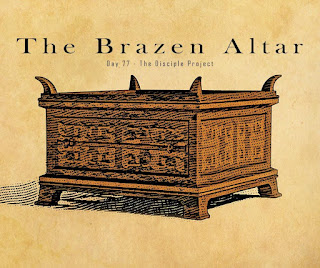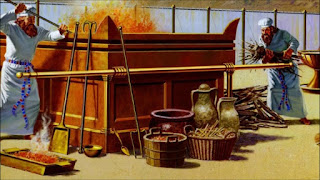THE LIVES OF THE PATRIACHS #164 | THE LIFE OF MOSES #145
Pastor Christopher Choo
Lesson 3850
THE LIVES OF THE PATRIACHS #164
THE LIFE OF MOSES #145
MOSES AT MT. SINAI #44
THE TABERACLE OF MOSES ( Part 3 )
The Brazen Altar
When a person entered through the court gate of that tabernacle, the first thing they would see was the Brazen Altar.
It reminded them they were not worthy to approach holy God without first offering a blood sacrifice for their sins.
Here is how God told Moses to make this altar:
"Build an altar of acacia wood, three cubits high; it is to be square, five cubits long and five cubits wide. Make a horn at each of the four corners, so that the horns and the altar are of one piece, and overlay the altar with bronze. Make all its utensils of bronze-its pots to remove the ashes, and its shovels, sprinkling bowls, meat forks and firepans. Make a grating for it, a bronze network, and make a bronze ring at each of the four corners of the network. Put it under the ledge of the altar so that it is halfway up the altar. Make poles of acacia wood for the altar and overlay them with bronze. The poles are to be inserted into the rings so they will be on two sides of the altar when it is carried. Make the altar hollow, out of boards. It is to be made just as you were shown on the mountain." ( Exodus 27:1-8, NIV)
This altar measured seven and a half feet on each side by four and a half feet high.
Bronze, an alloy of copper and tin, is often a symbol of God's righteousness and judgment in the Bible.
The Brazen Altar was placed on a mound of earth or stones so it was raised above the rest of the tabernacle ground. It probably had a ramp which the repentant
sinner and priest could walk up. On top was a bronze grate, with grates on all four sides. Once the fire was kindled in this altar, God ordered that it should not be allowed to die out (Leviticus 6:13).
The horns on the four corners of the altar represented God's power. The animal would have been tied to the horns before being sacrificed.
Note that this altar and the implements in the courtyard were overlaid with common bronze, but the altar of incense, inside the Holy Place in the tabernacle tent, was overlaid with precious gold because it was close to God.
Christians believe that, like the other parts of the tabernacle, the Brazen Altar pointed to the coming Messiah, Jesus Christ.
God's plan for the salvation of humanity called for a spotless, sinless sacrifice. Only Jesus met that requirement. To atone for the sins of the world, Christ was sacrificed on the altar of the cross.
John the Baptist said of him, "Look, the Lamb of God, who takes away the sin of the world!" (John 1:29, NIV) Jesus died as the sacrificial lamb, just as the lambs and sheep had died on the brazen altar more than a thousand years before him.
The difference was that Christ's sacrifice was final. No more sacrifices were needed. God's holy justice was met.
People seeking to enter heaven today need only accept God's gracious gift of salvation through faith in his Son as sacrifice and Savior.
Conclusion
The brazen altar was a portable construct and the largest of the tabernacle’s seven pieces of furniture.
Placed in the outer court of the wilderness tabernacle (Exodus 40:6), the brazen altar was the most prominent and imposing object in the court, and no worshiper could avoid seeing it upon entering.
Once the brazen altar was consecrated, whatever touched it became holy (Exodus 29:37). The Israelites made daily sacrifices to God on the brazen altar (Exodus 29:38). As the first priests began their service at the tabernacle, fire from the presence of the Lord consumed the sacrifice (Leviticus 9:24). According to Leviticus 6:13, the fire of the altar was to be kept burning at all times. The horns of the altar were to be covered with blood at the consecration of the priests (Exodus 29:1, 10–12; Leviticus 8:14–15; 9:9) and on the Day of Atonement (Leviticus 16:18).
The brazen altar—where Israel’s priests offered substitutionary animal sacrifices for the sins of the people—vividly illustrated the basics of atonement for sin.
Only by blood sacrifice was sin atoned. The brazen altar, ever ablaze and covered in blood, always stood open to accept the guilt of any Hebrew person who wished to come near to God. There the guilty sinner would offer another life, an innocent one, in his stead.
The holiness and righteousness of God were displayed on the brazen altar. It was the place where sin was judged and its penalty paid. The brazen altar opened the way to approach God and find His mercy. Everything that touched the brazen altar was made holy. Jesus Christ is our brazen altar: “He personally carried our sins in his body on the cross so that we can be dead to sin and live for what is right” (1 Peter 2:24, NLT).









